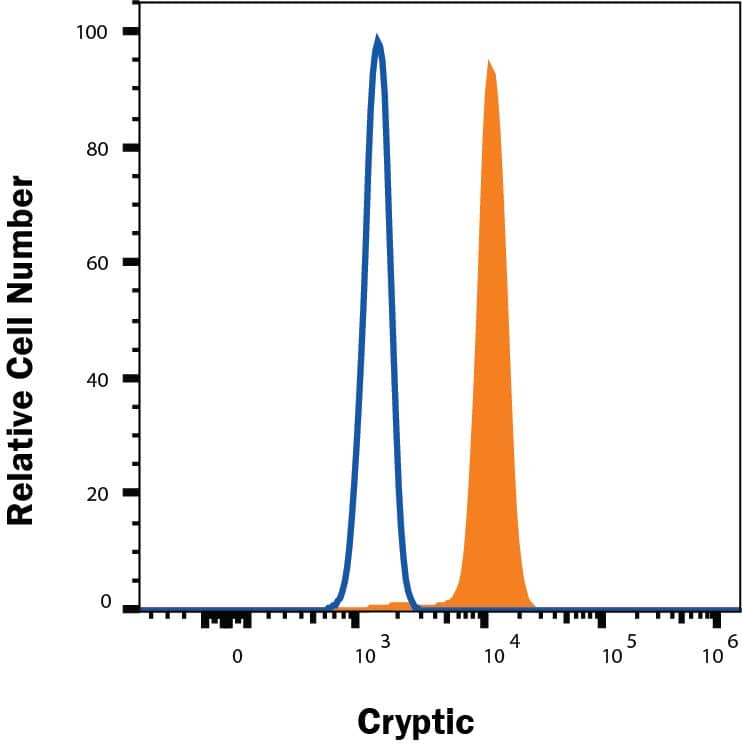Human Cryptic Antibody
R&D Systems, part of Bio-Techne | Catalog # AF1410


Key Product Details
Species Reactivity
Applications
Label
Antibody Source
Product Specifications
Immunogen
Tyr26-Gly169
Accession # NP_115934
Specificity
Clonality
Host
Isotype
Scientific Data Images for Human Cryptic Antibody
Detection of Cryptic in iPSC mesoderm differentiated cells by Flow Cytometry.
iPSC mesoderm differentiated cells treated with iPSC kit for Mesoderm differentiation (SC030B) were stained with Sheep Anti-Human Cryptic Antigen Affinity-purified Polyclonal Antibody (Catalog # AF1410, filled histogram) or isotype control antibody (Catalog # 5-001-A, open histogram), followed by Phycoerythrin-conjugated Anti-Sheep IgG Secondary Antibody (Catalog # F0126). To facilitate intracellular staining, cells were fixed and permeabilized with FlowX FoxP3 Fixation & Permeabilization Buffer Kit (Catalog # FC012). View our protocol for Staining Intracellular Molecules.Applications for Human Cryptic Antibody
CyTOF-ready
Intracellular Staining by Flow Cytometry
Sample: iPSC mesoderm differentiated cells treated with iPSC kit for Mesoderm differentiation (Catalog # SC030B)
Western Blot
Sample: Recombinant Human Cryptic (Catalog # 1410-CR)
Formulation, Preparation, and Storage
Purification
Reconstitution
Formulation
Shipping
Stability & Storage
- 12 months from date of receipt, -20 to -70 °C as supplied.
- 1 month, 2 to 8 °C under sterile conditions after reconstitution.
- 6 months, -20 to -70 °C under sterile conditions after reconstitution.
Background: Cryptic
Cryptic, also known at CFC-1, was originally identified as a secreted protein that is specifically expressed during mesoderm differentiation (1). Cryptic, along with Cripto, Xenopus FRL-1 and zebrafish OEP (one-eyed pinhead) define the epidermal growth factor-CriptoFRL1Cryptic (EGF-CFC) family of signaling proteins that function in cancer and various developmental processes (2, 3). Overall sequence identity between members of the family is low, but they do share distinct domains: a variant EGF-like motif, a novel conserved cysteine-rich domain (called CFC domain), and a C-terminal hydrophobic region (2). Most EGF-CFC members have a glycosyl-phosphatidylinositol (GPI) anchoring site at the C-terminus and exist as extracellular membrane-anchored proteins. However, naturally-occurring soluble isoforms also exist. Human Cryptic shares 55% and 25% amino acid idenitity with mouse Cryptic and human Cripto, respectively. Despite weak conservation in amino acid identity, EGF-CFC family members appear to function similarly in assays for phenotypic rescue of zebrafish oep mutants (2).
Cryptic is expressed during gastrulation in the mesoderm and later in the neuroectoderm, marking the prospective floor plate of the neural tube (1). Genetic evidence from mice and humans points to a role for Cryptic in determining left-right asymmetry. Mutations in the cryptic gene result in a spectrum of heart, lung and spleen defects, all representing left-right laterality defects (4, 5). These phenotypes resemble some Nodal mutant alleles suggesting that Cryptic, like Cripto, acts as an essential co-factor for Nodal signaling (1, 3). Studies have shown that other TGF-beta superfamily members involved in mesoderm induction and left-right patterning, Vg1 and GDF-1, also require EGF-CFC co-factors. Cryptic binds to GDF-1 leading to an Act RIIB-ALK4-Cryptic-GDF-1 complex for signaling (6).
References
- Shen, M. et al. (1997) Development 124:429.
- Shen, M. and A. Schier (2000) Trends Genet. 16:303.
- Rosa, F.M. (2002) Science's STKE http://stke.sciencemag.org/.
- Gaio, U. et al. (1999) Curr. Biol. 9:1339.
- Bamford, R. et al. (2000) Nature Genet. 26:365.
- Cheng, S. et al. (2003) Genes & Dev. 17:31.
Alternate Names
Gene Symbol
UniProt
Additional Cryptic Products
Product Documents for Human Cryptic Antibody
Product Specific Notices for Human Cryptic Antibody
For research use only